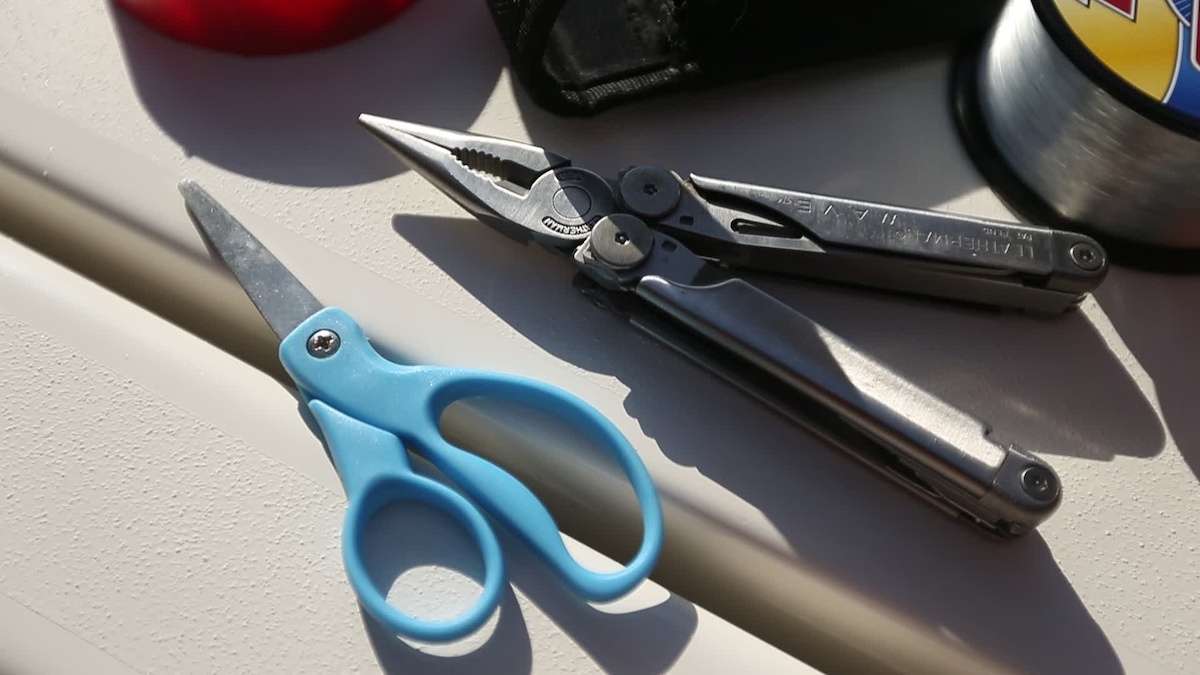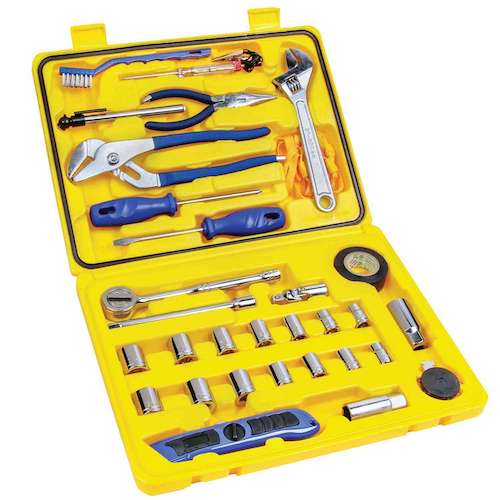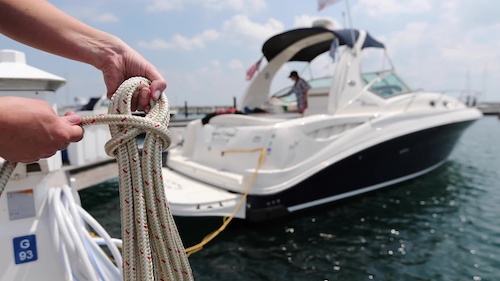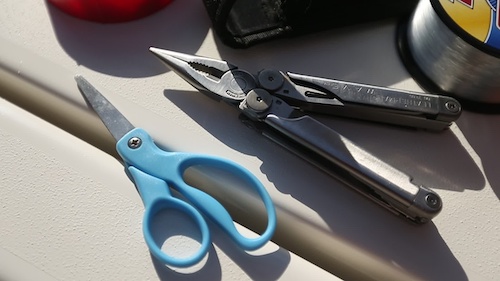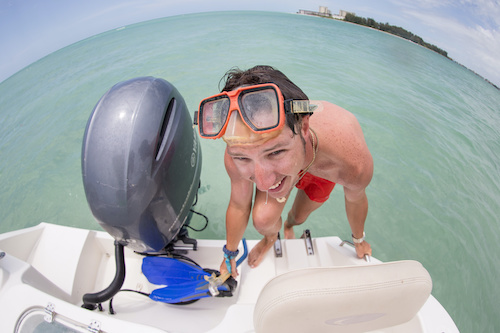Boats of all shapes and sizes, especially boats that head offshore or long distancing cruising, should always be well-stocked with a proper onboard tool kit. Cruising sailboats, for example, head offshore with a literal ton of tools and spares for emergencies in remote locations.
When you're getting ready to pack your own boat tool kit, you can pack just 15 things to save the average day or weekend on the water. Most of the items below can be packed into a single, soft-sided took kit that can live aboard or be moved from boat to boat.
Boat Tool Kit Essentials List
- Multi-tool
- Rigging knife
- Headlamp
- Tape
- Line and string
- Cable ties
- Pliers
- Screwdrivers
- Socket and wrench set
- Spare bulbs, fuses and belts
- Thread locking fluid
- Telescoping mirror and magnet
- Jumper cables
- Wooden plugs
- Mask and snorkel
Now, let's dive into the details and the reasoning behind each of these tools.
The Ultimate Boat Maintenance Guide
1. Multi-Tool
A multi-tool is the bare minimum for quick jobs, and you can pack it easily if you’re overnighting or cruising on other people’s boats. The basics include flat and Philips head screwdrivers, pliers, assorted knives, a saw, and in even a corkscrew.
2. Rigging Knife
Most sailors, in particular, have a rigging knife in a pocket or attached to their belt. Smaller and lighter than multi-tools, these knives also come with a marlinspike to loosen tight knots in lines and a shackle key. Most also have a tether so they don’t go fall into the water.
3. Headlamp
Because problems don’t just occur during daylight hours, you’ll need a flashlight and a headlamp is perfect to keep your hands free to work. Small, inexpensive LED headlamps can be purchased anywhere and some even come with a red or white light so you don’t blow your night vision when peek at a dark compass or a chart. You can even use them to grill at night or find your pet hiding belowdecks.
4. Tape
Any kind of tape is good. Electrical tape is fantastic for fixing everything from loose wiring to shoes that are falling apart. Self-amalgamating silicone tape sticks to itself and is a one-size-fits all bonding material that is small and light. For bigger emergency fixes, bring along some duct tape that can be used as temporary leak repair.
5. Line and String
Boats are already a tangle of lines, but you can never have too much. You never know when you'll need a spare docking line, a replacement line to drop anchor, or even an extra line to tie off a fender.
5 Basic Boating Knots for Beginners
6. Cable ties
Cable ties are great when line isn’t available. These small strips of plastic are strong enough to take on a real mechanical challenge but can also be used to secure a pirate flag. You can even use them as a very temporary backup to a failed hose clamp. They’re small and light, so keep a dozen in assorted sizes.
7. Pliers
You can fit an assortment of pliers in a pouch to grab and go. Include needle nose pliers, wire strippers and even a set of locking pliers that can handle jobs of different sizes. Whether you need to hold something in place or wiggle something free, pliers are great.
8. Screwdrivers
Flathead and Phillips screwdrivers in a couple of sizes are a must. Not just for the obvious jobs of tightening or loosening screws, screwdrivers can be used to double as a broken gear shift handle or as a small pry bar to open a stuck locker. Some screwdrivers come with multiple heads to switch out according to need.
9. Socket and Wrench Set
A small (maybe 12-piece) socket/wrench set could make the difference between a day on the water and a day stuck in the slip. These sets are inexpensive but the cheaper you go, the more likely the tools will rust in the marine environment.
10. Spare Bulbs, Fuses and Belts
It’s usually the small or overlooked items that cause the most annoying situations. A blown fuse could mean the bilge pump stops working so carry a few DC, AC and cartridge fuses for fast replacement. Spare bulbs can be swapped in quickly to make lights work and a spare belt for the engine can make the difference in getting back into the slip safely.
11. Thread Locking Fluid
This one is many for all your sailors out there—sailboats move and with the constant vibration and strain, things that should stay tight, come loose. Keeping a nut securely on a bolt, as in for example a water pump, will be easier with thread locking fluid. There are many brands of this thin adhesive that keeps nuts and bolts from loosening, leaking or corroding.
12. Telescoping Mirror and Magnet
Boats are notorious for having difficult-to-access spaces and deep bilges and it’s Murphy’s Law that the one bolt you loosened will fall somewhere where you can’t see or reach it. A polished steel telescoping mirror will let you peek under the engine or even around behind a locker. An accompanying telescoping magnet will reach that runaway bolt hiding in the murky bilge water.
13. Jumper Cables
All powerboats have a marine battery, and even most sailboats have auxiliary power, which means they also have a battery. It’s easy to run out of juice when running lights, the stereo, and other connected electronics, so cables can save the day. They won’t reach from one boat to another, but you can borrow a 12V battery and bring it aboard to get the engine started.
14. Wooden Plugs
Again, another one for all you sailors—hoses can come loose and that usually means water ingress. Whether the hose popped on the head intake or a thru-hull fitting has failed, a wooden plug may be the only thing that will keep the boat afloat for the day. Most chandleries sell round, wooden or foam plugs in bags of assorted sizes.
15. Mask and Snorkel
Not all problems occur on deck or in the cabin. Some issues develop under the waterline so keep a basic, inexpensive mask and snorkel on hand in case you have to cut away line wrapped on a prop or untangle kelp stuck on the keel. You’ll be able to see the problem better and get the job done faster.
Read Next: First-Time Boat Owners Checklist
You May Also Like:
